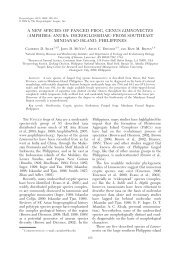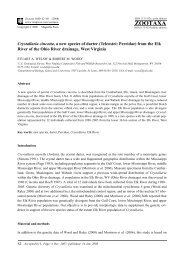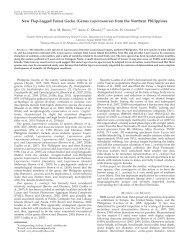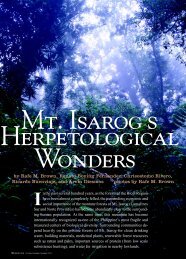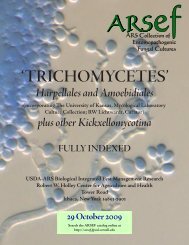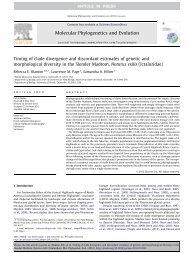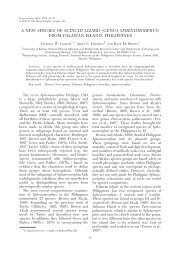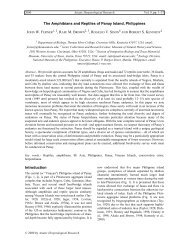(Percidae: Etheostoma), with Descriptions of Five New Species
(Percidae: Etheostoma), with Descriptions of Five New Species
(Percidae: Etheostoma), with Descriptions of Five New Species
- No tags were found...
Create successful ePaper yourself
Turn your PDF publications into a flip-book with our unique Google optimized e-Paper software.
22 Bulletin 30 NOVEMBER 1, 2012dividual tubercles on medial-distal portions <strong>of</strong> rays 3–5.Anal fin spines and anterior rays usually <strong>with</strong> tubercularridges, grading into broken ridges and individual roundedtubercles on posterior rays; smaller individuals tend todevelop short ridges and rounded tubercles on most rays.Ventral body scale tubercles typically not as well developed,occurring on up to 4 midventral scale rows on posteriorhalf <strong>of</strong> belly. Tuberculate males have been found incollections from 7 March to 20 May (Duck River, Marshalland Bedford counties, Tennessee).Distribution.—This species is endemic to the Duck andBuffalo Rivers <strong>of</strong> the Tennessee River drainage, Tennessee(Fig. 5). In the Duck River it occurs below NormandyDam in the Nashville Basin and western Highland Rimdownstream past the confluence <strong>of</strong> Buffalo River to thebackwaters <strong>of</strong> Kentucky Lake. It occurs in the BuffaloRiver, located wholly on the western Highland Rim, fromupper reaches downstream to its mouth. <strong>Etheostoma</strong> obamais distributed parapatrically <strong>with</strong> E. jessiae, which occurs inTennessee River tributaries upstream, and in at least onetributary downstream (Whiteoak Creek), <strong>of</strong> Duck River.Etymology.—The common name spangled darter refersto the bright orange spots adorning the body and fins<strong>of</strong> breeding males. The species epithet is a noun in appositionthat honors President Barack Obama (Fig. 11),the 44 th President <strong>of</strong> the United States <strong>of</strong> America, andhis environmental leadership and commitment duringchallenging economic times in the areas <strong>of</strong> clean energy,energy efficiency, environmental protection and humanitarianefforts globally, and especially for the people <strong>of</strong> theUnited States.Comments.—Only five specimens from the Duck Riversystem were available to Howell (1968), and presumablybecause they lacked a frenum he treated them as nominalE. stigmaeum. Etnier and Starnes (1994) examined 46 additionalspecimens from the system and reported modalcounts <strong>of</strong> dorsal fin spines, dorsal fin s<strong>of</strong>t rays, anal finrays, and pectoral fin rays that are closer to those <strong>of</strong> E.jessiae. They suggested possible intergradation betweennominal E. stigmaeum, invading from the CumberlandRiver (recognized herein as a new species), and E. jessiae.Examination <strong>of</strong> 185 specimens, observations <strong>of</strong> breedingcolors in the upper and lower reaches <strong>of</strong> the system, andsurvey <strong>of</strong> allozyme variation (Layman, 1994) indicate thatthe population from the Duck River system is distinguishableand diagnosable as a species. The phylogenetic hypothesispresented below suggests that meristic similaritiesbetween E. obama and E. jessiae may best be explainedby more recent common ancestry <strong>of</strong> E. obama <strong>with</strong> E. jessiaethan <strong>with</strong> nominal E. stigmaeum.



